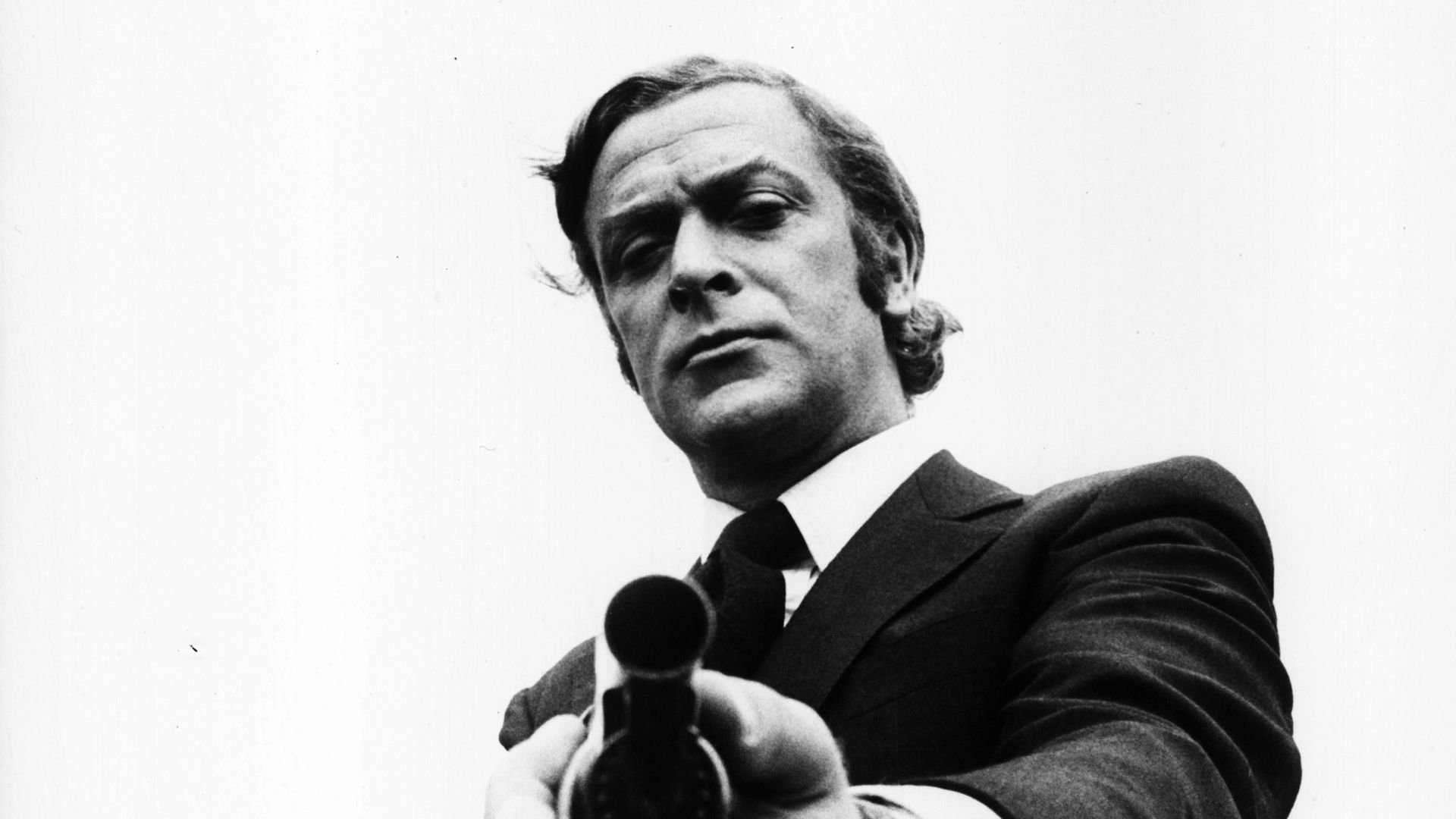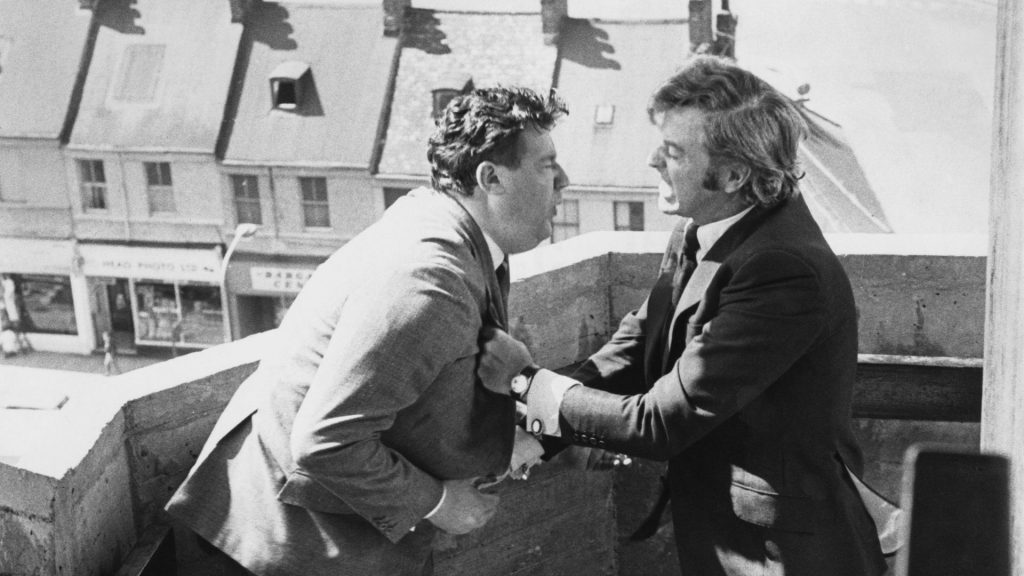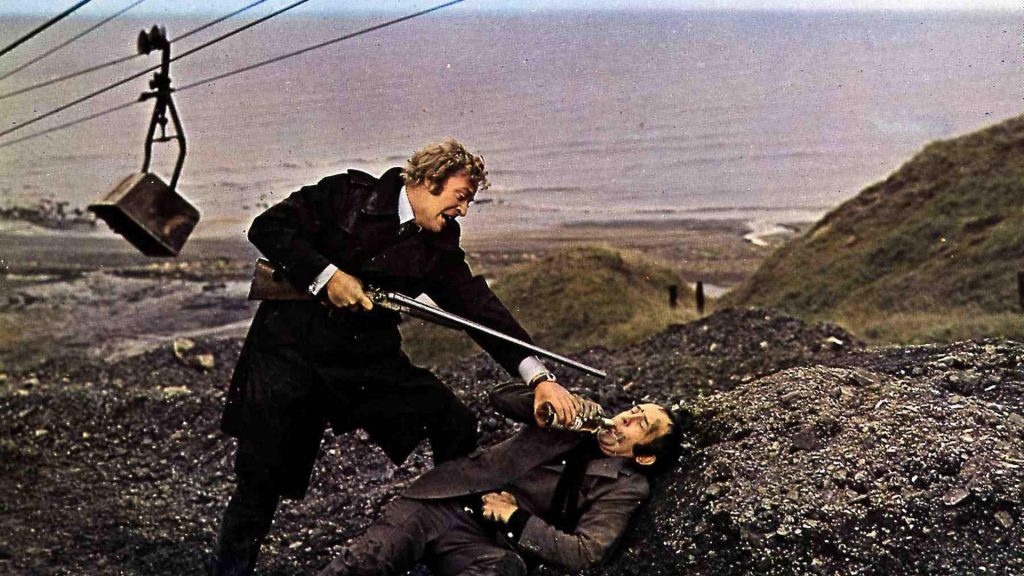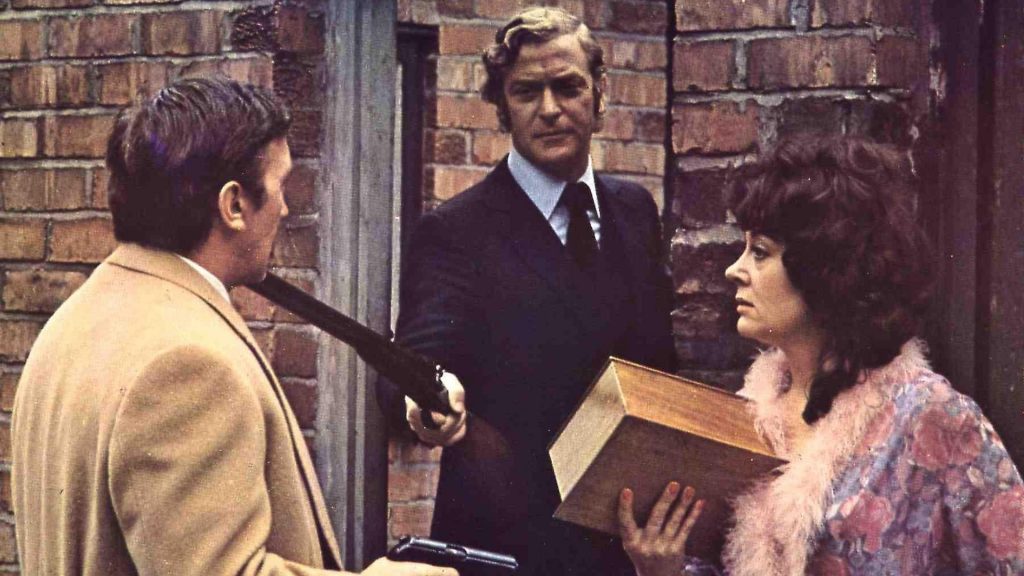
Fifty years ago, Michael Caine strode onto screens as the eponymous hero of Get Carter. In a navy-blue three-piece suit, with shotgun in hand he not only dragged British cinema into the 1970s but captured a great city on the cusp of change. By Roger Domeneghetti
As the thrumming sound of the train segues into Roy Budd’s classic funk soundtrack, Michael Caine’s avenging angel of the north, Jack Carter, hurtles along the East Coast Main Line.
His journey starts from London in daylight but the skies blacken as England races past, and other hints of the darkness to come are glimpsed – a newspaper headline refers to the gangland feud that underpins the film, while Carter reads a paperback copy of Raymond Chandler’s Farewell, My Lovely, a portent of his demise.
As the train rolls into Newcastle – and the insistent soundtrack finally slows down and the opening credits end – night has fallen and the city is in darkness.
Carter’s place in a first-class carriage and his well-cut blue suit are early signs of his social mobility and his place as an outsider is reinforced on his arrival in Newcastle. As he enters a pub opposite the station, the film cuts between him walking, suited and booted, to the bar through rather more dourly dressed locals drinking and talking, one of whom has six fingers on one hand. Carter orders a pint of bitter “in a thin glass”.

So begins Get Carter, a tale of bloody retribution across the North East that not only dragged British cinema into the 1970s, but also depicted a divided country, and a region on the cusp of change.
Based on the novel Jack’s Return Home, by Ted Lewis, the film tells the story of Caine’s Carter, a gangster who travels from London to his hometown of Newcastle following the death of his brother in a car crash.
Ostensibly there for the funeral, Carter finds it hard to accept the death was an accident and starts asking questions. He ultimately finds out that his brother was killed after he discovered underground pornographers had coerced Carter’s 16-year-old niece into taking part. This grim realisation propels him towards brutal revenge and, ultimately, his own death.
Debutant director Mike Hodges was sent the book by producer Mike Klinger and, working with a budget of just £462,000, paltry even for the time, he took just 40 weeks to write the screenplay, film and then cut a final edit.
While the film has become inextricably linked to Newcastle, the book was actually set in Scunthorpe. It was Hodges who moved the location further north.
“As soon as I saw it, I knew that’s where I wanted to shoot,” he said in an interview with the Guardian in 2011. “It was such an incredibly visual city. It didn’t look like a British city. It looked like Chicago or New York.” Caine agreed, writing that the city had “a grim Victorian beauty of its own” that was “eminently photogenic”. The decrepit backdrop also provided a visual metaphor for the amoral world in which Carter existed.
At the time, Newcastle was in the throes of an irreversible Brutalist restructuring instigated in the mid-1960s by the then-council leader T Dan Smith. Arrested and charged with corruption in early 1970, Smith was found not guilty. Arrested again in 1973 on similar charges, he pleaded guilty and was jailed for six years, a sentence which has defined his legacy.
Like many at the time, Smith was convinced that high-rise tower blocks should replace slum housing. Swaths of Georgian architecture were also demolished to make way for a city-centre shopping arcade and the Central Motorway, Smith seeing the city’s future as the “Brasilia of the North”.
Get Carter, therefore, is a snapshot of a city in transition. The old was being knocked down. However, the debris had not been swept away, nor the new fully built to replace it. We see a lost Newcastle of crumbling terraced houses sloping down to the Tyne with industrial chimneys belching out smoke beyond.
Yet we also see Smith’s vision of a new Tyneside beginning to take shape, nowhere more so than in Gateshead’s Trinity Square car park from which Carter dispatched corrupt arcade owner Cliff Brumby (played by Bryan Mosley) to his death. Opened in 1967, the concrete multi-storey structure dominated the town centre and had space for a top-floor restaurant. It was an emblem of post-industrial regeneration.
However, due to safety concerns the restaurant was never opened, and the upper parking levels were closed in the mid-1990s. The building, widely known as the “Get Carter car park”, was closed for good in 2008. Despite a campaign to save it in large part due to its connections with the film, it was demolished in 2010.

This realistic approach was one of the main reasons Caine took the role. He had grown up with men like Carter and had become frustrated with what he considered to be an unrealistic portrayal of gangsters as harmless idiots or “Robin Hood types”. He knew what they were really capable of and wanted to portray that. “In real life, every single punch in the face tears skin and cartilage, and often breaks bones,” he later wrote in his autobiography. “We decided to make the movie more realistic in this respect. We had to show violence as it really was.”
Critics compared Caine unfavourably to Humphrey Bogart and taking the part had been something of a risk for the actor. Not yet 40, he had only just established himself as a leading man. His breakthrough role, in Zulu, came seven years prior, in 1964. His first outing as Harry Palmer, the insouciant pseudo-James Bond, followed 12 months after that. Alfie, for which Caine received his first Oscar nomination, came another year later.
Yet, this overt break with his previous roles was the appeal of taking the part. As Caine explained in his autobiography: “One’s appearance distracts people from one’s acting. Carter was real.”
Nowhere was this more obvious than when contrasting the role with Caine’s previous outing as a gangster: Charlie Croker in The Italian Job, released in 1969. With a tongue-in-cheek, joie de vivre, the film has come to epitomise the 1960s. The colour pallet is vibrant, what little violence there is happens off screen, or to cars. The sex has the air of a Benny Hill episode, not least because Hill himself is in the film, playing to type.
Get Carter is altogether different. It is an intense, at times unsettling, revenge tale. It is played out in down-at-heel pubs, bookies, and grimy back streets set against slate grey skies. The violence, although tame by modern standards, was graphic enough at the time to receive an X certificate, the equivalent to an 18 today. The sex was exploitative and stripped of fun.
The film was one of a slew of violent films released in the same year, including Dirty Harry, Straw Dogs, The French Connection and A Clockwork Orange that washed away the last vestiges of the 1960s’ optimism. For a decade that included the three-day week, IRA bombings, the rise of the National Front and ended with the Winter of Discontent, Get Carter was an entirely appropriate opening act.
After a strong opening couple of weeks, Get Carter’s box office performance faded away. “I think the problem was that I was showing a side of Britain that people didn’t want to see,” said Hodges some 30 years later.
Critics were also ambivalent, acknowledging the professional skill with which the film had been made, but baulking at its violent subject matter. George Melly, writing in the Observer, likened it to “a bottle of neat gin swallowed before breakfast”. A review in the trade publication Kinematograph Weekly described it as “a horrid story” of “almost unrelieved, callous brutality”.
The bleak depiction of the underbelly of northern Britain had been magnified by the cinéma vérité style employed by Hodges, who had cut his teeth producing and directing documentaries for the investigative current affairs programme World in Action. Aided and abetted by cinematographer Wolfgang Suschitzky, who had a similar professional background, Hodges created a commercial film with an international star, shot not on a sound stage or set but in front of real scenery and people, almost as if they were unaware. It made early 1970s Newcastle more than just a setting, but a character in itself.
By the 1990s, Tyneside and the wider north east was enjoying something of a renaissance built upon some of the changes initiated by Smith.
The Metro, a light rail-cum-underground system opened in 1980. It was the first of its kind in the UK. Six years later, the Metro Centre was opened on the site of the decommissioned Dunston power station, which looms large in several scenes in Get Carter. It was one of the first, and is still one of the largest, out-of-town shopping centres in the country.

The Georgian buildings of Grainger Town in the heart of Newcastle, underwent regeneration. The riverbanks on both the Newcastle and Gateshead sides of the Tyne were redeveloped as cultural and social hubs.
The film too was revitalised. Prior to the age of home video and with limited screenings on TV (there was just one broadcast for audiences outside London in the 15 years after the film’s release) Get Carter became little more than an entry in the filmographies of those who took part in its production.
That began to change in 1993 when Quentin Tarantino, fresh from the success of his debut, Reservoir Dogs, listed Get Carter as one of his favourite British films. The young auteur’s praise prompted the start of a critical reappraisal.
In the heady summer of 1996 infused with cigarettes and alcohol, played out against the backdrop of Euro ’96 and a Britpop soundtrack, Loaded magazine serialised the film in a cartoon strip. In this cultural milieu, Get Carter found a new, receptive audience.
Two years later the British gangster film genre was reinvigorated by Guy Ritchie’s debut Lock, Stock and Two Smoking Barrels. A self-confessed fan of Get Carter, Ritchie evoked the film in his own marketing, which featured footballer-cum-actor Vinnie Jones casually carrying two shotguns – Carter’s weapon of choice – over his shoulders. By the end of the decade, the BFI released a restored print and described the film as “the best British Gangster movie ever made”. Get Carter’s resurrection was complete. Tyneside’s continues.
Coals to Newcastle
The climactic final scene on a coal-strewn beach was shot at Blackhall, further south along the coast near Hartlepool, where spoilings from a mine were dumped by a conveyor system.
Like other locations, like the Trinity Square car park, the beach is now unrecognisable from its appearance in the film.
The conveyor, known by locals as the ‘Flight’, was removed along with other infrastructure as part of a multi-million-pound scheme to renovate the area and clean up the beach in the 2000s. The coal waste was also removed and the beach is now pristine.
What do you think? Have your say on this and more by emailing letters@theneweuropean.co.uk
Five times the north east has starred on screen
Cul-de-Sac (1966)
The psychological thriller was Roman Polanski’s second film in English, and featured Donald Pleasence and a young Jacqueline Bisset. It was filmed mainly on the Holy Island of Lindisfarne and the tidal causeway that leads to it. The sense of claustrophobia the setting provided helped Cul-de-Sac scoop the Golden Bear at the 16th Berlin International Film Festival.
Whatever Happened to the Likely Lads (1973-1974)
This sequel to 1960s sitcom The Likely Lads followed middle-class and socially aspirational Bob (Rodney Bewes) and working-class Terry (James Bolam) as they adjusted to life in the 1970s. The Newcastle backdrop provided a visual metaphor of that change, nowhere more so than in the end credits, which show a group of children playing in the rubble of a demolished terraced house. Through its broken windows can be seen new tower blocks rising in the background.
Our Friends in the North (1996)
The drama series charted 30 years in the lives of four Geordie friends, with one story line drawing on the travails of T Dan Smith. Inspired by Shakespeare’s Henry IV it was initially pitched as a story about “post-War social housing policy”. BBC executives nearly passed. However, the setting and subject matter were crucial. It ultimately won three Baftas and widespread critical acclaim.
Billy Elliot (2000)
Set in the fictional village of Everington at the height of the miners’ strike, Billy Elliot was filmed among the evocative terraces of Easington Colliery. The filmmakers occasionally play fast and loose with geographic reality. One scene sees Billy cross the Transporter Bridge over the River Tees in the heart of Middlesbrough, a 20-mile detour in the wrong direction.
I, Daniel Blake (2016)
Shot on location in and around Newcastle, I, Daniel Blake was a typically hard-hitting Ken Loach film that shone a light on the indignities and absurdities of the benefits system. Despite the political debate that surrounds the film, it won the Palme d’Or at the 2016 Cannes Film Festival and the 2017 BAFTA for Outstanding British Film.









